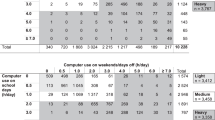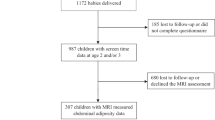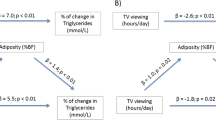Abstract
Objective:
TV viewing and computer use is associated with childhood overweight, but it remains unclear as to how these behaviours could best be targeted. The aim of this study was to determine to what extent the association between TV viewing, computer use and overweight is explained by other determinants of overweight, to find determinants of TV viewing and computer use in the home environment and to investigate competing activities.
Method:
A cross-sectional study was carried out among 4072 children aged 4–13 years in the city of Zwolle, the Netherlands. Data collection consisted of measured height, weight and waist circumference, and a parental questionnaire on socio-demographic characteristics, child's nutrition, physical activity (PA) and sedentary behaviour. Associations were studied with logistic regression analyses, for older and younger children, boys and girls separately.
Results:
The odds ratio (OR) of being overweight was 1.70 (95% confidence interval (CI): 1.07–2.72) for viewing TV >1.5 h among 4- to 8-year-old children adjusted for all potential confounders. Computer use was not significantly associated with overweight. Determinants of TV viewing were as follows: having >2 TVs in the household (OR: 2.38; 95% CI: 1.66–3.41), a TV in the child's bedroom and not having rules on TV viewing. TV viewing and computer use were both associated with shorter sleep duration and not with less PA.
Conclusion:
Association between TV viewing and overweight is not explained by socio-demographic variables, drinking sugared drinks and eating snacks. Factors in the home environment influence children's TV viewing. Parents have a central role as they determine the number of TVs, rules and also their children's bedtime. Therefore, interventions to reduce screen time should support parents in making home environmental changes, especially when the children are young.
This is a preview of subscription content, access via your institution
Access options
Subscribe to this journal
Receive 12 print issues and online access
$259.00 per year
only $21.58 per issue
Buy this article
- Purchase on Springer Link
- Instant access to full article PDF
Prices may be subject to local taxes which are calculated during checkout
Similar content being viewed by others
References
Ebbeling CB, Pawlak DB, Ludwig DS . Childhood obesity: public-health crisis, common sense cure. Lancet 2002; 360: 473–480.
Daniels SR . The consequences of childhood overweight and obesity. Fut Children 2006; 16: 47–67.
Jackson-Leach RL, Lobstein T . Estimated burden of paediatric obesity and co-morbidities in Europe. Part 1. The increase in the prevalence of child obesity in Europe is itself increasing. Int J Pediatr Obes 2006; 1: 26–32.
Deshmukh-Taskar P, Nicklas TA, Morales M, Yang SJ, Zakeri I, Berenson GS . Tracking of overweight status from childhood to young adulthood: the Bogalusa Heart Study. Eur J Clin Nutr 2006; 60: 48–57.
Yang X, Telama R, Leskinen E, Mansikkaniemi K, Viikari J, Raitakari OT . Testing a model of physical activity and obesity tracking from youth to adulthood: the cardiovascular risk in young Finns study. Int J Obes (Lond) 2007; 31: 521–527.
WHO. Obesity: Preventing and Managing the Global Epidemic: Report of a WHO Consultation. World Health Organization: Geneva, Switzerland, 1999.
Adachi-Mejia AM, Longacre MR, Gibson JJ, Beach ML, Titus-Ernstoff LT, Dalton MA . Children with a TV in their bedroom at higher risk for being overweight. Int J Obes (Lond) 2007; 31: 644–651.
van Zutphen M, Bell AC, Kremer PJ, Swinburn BA . Association between the family environment and television viewing in Australian children. J Paediatr Child Health 2007; 43: 458–463.
Saelens BE, Sallis JF, Nader PR, Broyles SL, Berry CC, Taras HL . Home environmental influences on children's television watching from early to middle childhood. J Dev Behav Pediatr 2002; 23: 127–132.
Wijga AH, Scholtens S, Bemelmans WJ, Kerkhof M, Koppelman GH, Brunekreef B et al. Diet, screen time, physical activity, and childhood overweight in the general population and in high risk subgroups: prospective analyses in the PIAMA Birth Cohort. J Obes 2010; 2010: 9 pp.
Thomson M, Spence JC, Raine K, Laing L . The association of television viewing with snacking behavior and body weight of young adults. Am J Health Promot 2008; 22: 329–335.
Kremers SP, van der Horst K, Brug J . Adolescent screen-viewing behaviour is associated with consumption of sugar-sweetened beverages: the role of habit strength and perceived parental norms. Appetite 2007; 48: 345–350.
Must A, Tybor DJ . Physical activity and sedentary behavior: a review of longitudinal studies of weight and adiposity in youth. Int J Obes (Lond) 2005; 29 (Suppl 2): S84–S96.
Melkevik O . Is spending time in screen-based sedentary behaviors associated with less physical activity: a cross national investigation. Int J Behav Nutr Phys Activity 2010; 7: 46.
Dennison BA, Erb TA, Jenkins PL . Television viewing and television in bedroom associated with overweight risk among low-income preschool children. Pediatrics 2002; 109: 1028–1035.
Hoyos Cillero I, Jago R . Sociodemographic and home environment predictors of screen viewing among Spanish school children. J Public Health (Oxf) 2011; 33: 392–402.
Lampert T, Sygusch R, Schlack R . [Use of electronic media in adolescence. Results of the German Health Interview and Examination Survey for Children and Adolescents (KiGGS)]. Bundesgesundheitsblatt Gesundheitsforschung Gesundheitsschutz 2007; 50: 643–652.
van der Horst K, Oenema A, Ferreira I, Wendel-Vos W, Giskes K, van Lenthe F et al. A systematic review of environmental correlates of obesity-related dietary behaviors in youth. Health Educ Res 2007; 22: 203–226.
Golan M, Crow S . Parents are key players in the prevention and treatment of weight-related problems. Nutr Rev 2004; 62: 39–50.
Robinson TN . Reducing children's television viewing to prevent obesity: a randomized controlled trial. JAMA 1999; 282: 1561–1567.
de Jong E, Schokker DF, Visscher TL, Seidell JC, Renders CM . Behavioural and socio-demographic characteristics of Dutch neighbourhoods with high prevalence of childhood obesity. Int J Pediatr Obes 2011; 6: 298–305.
Fredriks AM, van Buuren S, Wit JM, Verloove-Vanhorick SP . Body index measurements in 1996–7 compared with 1980. Arch Dis Child 2000; 82: 107–112.
Cole TJ, Bellizzi MC, Flegal KM, Dietz WH . Establishing a standard definition for child overweight and obesity worldwide: international survey. BMJ Clinical Res 2000; 320: 1240–1243.
Cole T, Flegal K, Nicholls D, Jackson A . Body mass index cut offs to define thinness in children and adolescents: international survey. BMJ Clin Res 2007; 335: 194.
CBS. Statistisch Jaarboek 2000 Statistics Netherlands (CBS). CBS: Heerlen, The Netherlands, 2000.
Bornstein MH, Bradley RH . Socioeconomic Status, Parenting, and Child Development. Lawrence Erlbaum Associates: Mahwah, NJ, 2003.
Kemper HCG, Ooijendijk WTM, Stiggelbout M . Consensus over de Nederlandse norm voor gezond bewegen. TSG 2000; 78: 180–183.
Voedingscentrum. Gezond Eten Gezond Bewegen Met Kinderen Van 4-8 Jaar [Healthy Eating Healthy Physical Activity with Children Aged 4. Dutch Nutrition Centre (Voedingscentrum): The Hague, The Netherlands.
Kimbro RT, Brooks-Gunn J, McLanahan S . Young children in urban areas: links among neighborhood characteristics, weight status, outdoor play, and television watching. Soc Sci Med 2011; 72: 668–676.
Vandewater EA, Rideout VJ, Wartella EA, Huang X, Lee JH, Shim MS . Digital childhood: electronic media and technology use among infants, toddlers, and preschoolers. Pediatrics 2007; 119: e1006–e1015.
Ortega FB, Chillon P, Ruiz JR, Delgado M, Albers U, Alvarez-Granda JL et al. Sleep patterns in Spanish adolescents: associations with TV watching and leisure-time physical activity. Eur J Appl Physiol 2010; 110: 563–573.
Hart CN, Cairns A, Jelalian E . Sleep and obesity in children and adolescents. Pediatr Clin N Am 2011; 58: 715–733.
Dewald JF, Meijer AM, Oort FJ, Kerkhof GA, Bogels SM . The influence of sleep quality, sleep duration and sleepiness on school performance in children and adolescents: a meta-analytic review. Sleep Med Rev 2010; 14: 179–189.
Baltissen A . Monitor Children Zwolle, Aged 0–12 year [Dutch: kindermonitor]. GGD Regio IJssel Vecht: Zwolle, The Netherlands, 2006.
Acknowledgements
We thank our partners in this monitoring study: the Zwolle city council, the local health services and several welfare organisations in the city. We also thank Sandra Bleeker and Hilly Langewen for the help in setting up the study. We are also greatly thankful to all the students who helped with the measurements, the participated schools and the sponsors.
Author information
Authors and Affiliations
Corresponding author
Ethics declarations
Competing interests
The authors declare no conflict of interest.
Rights and permissions
About this article
Cite this article
de Jong, E., Visscher, T., HiraSing, R. et al. Association between TV viewing, computer use and overweight, determinants and competing activities of screen time in 4- to 13-year-old children. Int J Obes 37, 47–53 (2013). https://doi.org/10.1038/ijo.2011.244
Received:
Revised:
Accepted:
Published:
Issue Date:
DOI: https://doi.org/10.1038/ijo.2011.244
Keywords
This article is cited by
-
RETRACTED ARTICLE: Childhood obesity risk increases with increased screen time: a systematic review and dose–response meta-analysis
Journal of Health, Population and Nutrition (2023)
-
Factors of heavy social media use among 13-year-old adolescents on weekdays and weekends
World Journal of Pediatrics (2023)
-
Screen time increases overweight and obesity risk among adolescents: a systematic review and dose-response meta-analysis
BMC Primary Care (2022)
-
The degree of consistency of applying parental dietary and sedentary behavior rules as indicators for overweight in children: a cross-sectional study
BMC Public Health (2022)
-
Psychometric properties of instruments to measure parenting practices and children’s movement behaviors in low-income families from Brazil
BMC Medical Research Methodology (2021)



